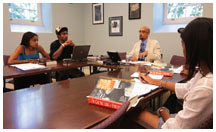
|
November 7, 2007: President's Page
THE ALUMNI WEEKLY PROVIDES THESE PAGES TO THE PRESIDENT
Assistant Professor of History and African American Studies Joshua Guild leads a class on “The Civil Rights Movement” in a beautifully renovated Stanhope Hall. (Denise Applewhite) |
A New Day for African American Studies
In a President’s Page last fall I wrote about Princeton’s vision for African American studies—one that places the study of race, and the African American experience in particular, at the center of academic life. As I noted in announcing the creation of our new Center for African American Studies, this is a field that “deals directly with one of the most durable and significant social problems faced by the American polity—and, indeed, insofar as it speaks to issues of racial identity and justice more generally, the world.” Moreover, African American studies is one of the most active areas of intellectual inquiry today, not only in its own right but also through its influence on other disciplines. By broadening the mandate and significantly increasing the resources of our former Program in African American Studies, we expect to have a major impact on the field, whether the measure is innovative scholarship, outstanding teaching, or interdisciplinary collaboration.
Today, within the space of one short year, the Center for African American Studies is well on its way to fulfilling our objectives, thanks to the enthusiasm of our faculty and the generosity of Princeton’s alumni. In the words of the center’s founding director, Woodrow Wilson Professor of Literature Valerie Smith, “2006-07 was an extraordinarily exciting year,” a year that witnessed the recruitment of new faculty and fellows, the revision and expansion of the curriculum, the strengthening of ties with other academic departments, and the renovation of historic Stanhope Hall to serve as the center’s home. In fact, so much is happening at Princeton that scholars around the United States have taken notice and, I am happy to say, have warmly endorsed our efforts.
The most visible sign of the revitalization of African American studies is the glorious rebirth of Stanhope Hall, Princeton’s third-oldest building, after many years of benign neglect. Its sandstone and ivy-clad walls were left intact, while its interior was completely reconstructed in a way that is faithful to its early 19th-century origins. It is inspiring to think that a building constructed at a time of slavery will now house scholars and students who explore and recount the experiences of those slaves and their descendants. Stanhope’s central location underscores our high hopes for the center—that it will play an integrative and catalytic role, serving as a focal point for scholarship and teaching as well as a source of ideas and opportunities that radiate outward to the four corners of our campus. Most of the center’s academic appointments, which will eventually double the size of its faculty, will be joint ones, not only in the humanities, where the center’s faculty is already strongly represented, but also in the arts, social sciences, and even the natural sciences.
This fall, together with the Departments of History, Sociology, and Religion, the center is welcoming three newcomers to its core faculty: Tera Hunter, an authority on the history of African American women; Angel Harris, whose research focuses on the “racial achievement gap” in American education; and Wallace Best, who has made significant contributions to the field of African American religious history. Professor of Religion Judith Weisenfeld *92, though not a joint appointment, will also have a close affiliation with the center, sharing her expertise on African American women’s history and cinematic and theatrical representations of African American religion. Moreover, there are outstanding offers that would bring additional strengths to the center through joint appointments with psychology, history, English, and the Woodrow Wilson School/sociology. Four new searches are under way this fall, leading, we hope, to a major new appointment in the field of race and public policy, as well as joint appointments with the Departments of Comparative Literature, Art and Archaeology, and Spanish and Portuguese Languages and Cultures. Since the center’s establishment, not a single candidate to whom we have made an offer has turned us down—a testament to the center’s current strength and future promise.
Augmenting the center’s intellectual menu this year are four distinguished visitors who will use their time at the center and in their host departments to pursue their research and share it with our faculty and students. The presence of Antonio Guimaraes from the University of São Paulo; Tyson King-Meadows from the University of Maryland; Imani Perry from our neighbor, Rutgers; and Kim Smith from Carleton College will add to the breadth and depth of the topics under study in the new center. Professor Smith, for example, is dividing her time between the center and the Princeton Environmental Institute, and through her work on African American environmental thought is helping our students to explore a fascinating—and critically important—crossroads of the humanities, natural sciences, and social sciences.
It would take much more than a single page to fully describe the ferment
of activity and spirit of excitement that is now pervading Stanhope Hall.
From new freshman and faculty-graduate seminars, to lectures and readings,
to further faculty recruitment and the inauguration of a new postdoctoral
fellowship program next fall, the groundwork is being laid for Princeton
to contribute in a truly significant way, through our teaching and research,
to understanding the impact that race has had on this country, and to
overcoming its pernicious effects. ![]()


